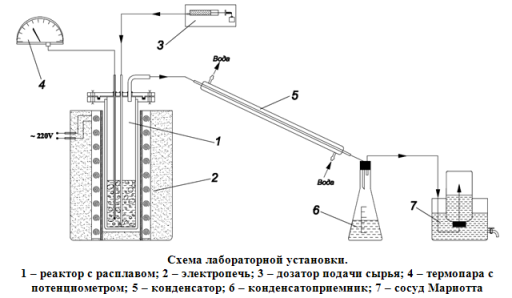Cracking of crude oil in the molten metals
DOI:
https://doi.org/10.15421/081312Keywords:
crude oil, cracking, molten metals, light petroleum products, catalytic indifferenceAbstract
In this paper is investigated the process of crude oil and its individual fractions cracking in the molten metals medium to produce light petroleum products. Thermodynamic calculations demonstrate the possibility of using lead and tin including alloys thereof as the melt. The cracking of West Siberian crude oil is studied at temperatures 400-600 °C. It is detected that as the temperature increases there is increase of aromatic hydrocarbons and olefins content in gasoline while naphthenes, n- and i-paraffins content reduces. Optimal temperature for cracking in molten metals is ~500 °C. The use of a submerged nozzle increases the yield of light petroleum products by ~2%. The research octane number of gasoline produced is 82-87 points. It is determined that the yield of light petroleum products depending on the experimental conditions is increased from 46.9 to 55.1-61.3% wt.References
Chekryishkin, Yu. S., Panteleev, E. V., Shakirov, I. V., Haymenov, A. P. Neorganicheskie rasplavyi-katalizatoryi prevrascheniya organicheskih veschestv, Moskow: Nauka, 1989, 134 p.
Buharkin, A. K. Kataliticheskie svoystva metallov i splavov v protsesse piroliza uglevodorodov, Moskow: Tehnika. «TUMA GRUPP» Ltd., 2001, 242 p.
Pechuro, N. S., Pesin, O. Yu., Konohov V. N. Technology of organic compounds. Moskow: VINITI, 1984, p. 3-59 (Itogi nauki i tehniki Vol. 9).
Chernousov, E. Yu., Glikin, M. A. Cracking of crude oil to melt metals. Tehnologiya 2013: mezhdunar. nauch.-tehn. konf.: tezisyi dokl. (Severodonetsk), 2013, p. 41.
Chernousov, E. Yu. Investigation of the process of cracking of hydrocarbons in the melt. Himiya i sovremennyie tehnologii: mezhdunar. nauch.-tehn. konf.: tezisyi dokl. (Dnepropetrovsk), 2013, vol. 2, p. 28.
Lepinskih, B. M., Monahov, A. I. Fizicheskaya himiya oksidnyih i oksiftoridnyih rasplavov, Moskow: Nauka, 1977, 190 p.
Mamedov, B. B., Kudryavtsev, S. A. Protsessyi vtorichnoy pererabotki nefti, Lugansk: izd-vo Vostochnoukr. nats. un-ta im. V. Dalya, 2010, 198 p.
Nefteproduktyi. Metodyi opredeleniya fraktsionnogo sostava. International standard 2177-99 (ISO 3405-88), IPK Izdatelstvo standartov, 1999, 28 p.

Downloads
Published
Issue
Section
License
Copyright (c) 2014 Vìsnik Dnìpropetrovsʹkogo unìversitetu. Serìâ Hìmìâ

This work is licensed under a Creative Commons Attribution 4.0 International License.
- Authors reserve the right of attribution for the submitted manuscript, while transferring to the Journal the right to publish the article under the Creative Commons Attribution License. This license allows free distribution of the published work under the condition of proper attribution of the original authors and the initial publication source (i.e. the Journal)
- Authors have the right to enter into separate agreements for additional non-exclusive distribution of the work in the form it was published in the Journal (such as publishing the article on the institutional website or as a part of a monograph), provided the original publication in this Journal is properly referenced
- The Journal allows and encourages online publication of the manuscripts (such as on personal web pages), even when such a manuscript is still under editorial consideration, since it allows for a productive scientific discussion and better citation dynamics (see The Effect of Open Access).

